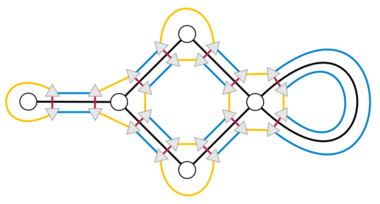Graph-encoded map
In topological graph theory, a graph-encoded map or gem is a method of encoding a cellular embedding of a graph using a different graph with four vertices per edge of the original graph.[1] It is the topological analogue of runcination, a geometric operation on polyhedra. Graph-encoded maps were formulated and named by (Lins 1982).[2] Alternative and equivalent systems for representing cellular embeddings include signed rotation systems and ribbon graphs.
The graph-encoded map for an embedded graph [math]\displaystyle{ G }[/math] is another cubic graph [math]\displaystyle{ H }[/math] together with a 3-edge-coloring of [math]\displaystyle{ H }[/math]. Each edge [math]\displaystyle{ e }[/math] of [math]\displaystyle{ G }[/math] is expanded into exactly four vertices in [math]\displaystyle{ H }[/math], one for each choice of a side and endpoint of the edge. An edge in [math]\displaystyle{ H }[/math] connects each such vertex to the vertex representing the opposite side and same endpoint of [math]\displaystyle{ e }[/math]; these edges are by convention colored red. Another edge in [math]\displaystyle{ H }[/math] connects each vertex to the vertex representing the opposite endpoint and same side of [math]\displaystyle{ e }[/math]; these edges are by convention colored blue. An edge in [math]\displaystyle{ H }[/math] of the third color, yellow, connects each vertex to the vertex representing another edge [math]\displaystyle{ e' }[/math] that meets [math]\displaystyle{ e }[/math] at the same side and endpoint.[1]
An alternative description of [math]\displaystyle{ H }[/math] is that it has a vertex for each flag of [math]\displaystyle{ G }[/math] (a mutually incident triple of a vertex, edge, and face). If [math]\displaystyle{ (v,e,f) }[/math] is a flag, then there is exactly one vertex [math]\displaystyle{ v' }[/math], edge [math]\displaystyle{ e' }[/math], and face [math]\displaystyle{ f' }[/math] such that [math]\displaystyle{ (v',e,f) }[/math], [math]\displaystyle{ (v,e',f) }[/math], and [math]\displaystyle{ (v,e,f') }[/math] are also flags. The three colors of edges in [math]\displaystyle{ H }[/math] represent each of these three types of flags that differ by one of their three elements. However, interpreting a graph-encoded map in this way requires more care. When the same face appears on both sides of an edge, as can happen for instance for a planar embedding of a tree, the two sides give rise to different gem vertices. And when the same vertex appears at both endpoints of a self-loop, the two ends of the edge again give rise to different gem vertices. In this way, each triple [math]\displaystyle{ (v,e,f) }[/math] may be associated with up to four different vertices of the gem.[1]
Whenever a cubic graph [math]\displaystyle{ H }[/math] can be 3-edge-colored so that the red-blue cycles of the coloring all have length four, the colored graph can be interpreted as a graph-encoded map, and represents an embedding of another graph [math]\displaystyle{ G }[/math]. To recover [math]\displaystyle{ G }[/math] and its embedding, interpret each 2-colored cycle of [math]\displaystyle{ H }[/math] as the face of an embedding of [math]\displaystyle{ H }[/math] onto a surface, contract each red--yellow cycle into a single vertex of [math]\displaystyle{ G }[/math], and replace each pair of parallel blue edges left by the contraction with a single edge of [math]\displaystyle{ G }[/math].[1]
The dual graph of a graph-encoded map may be obtained from the map by recoloring it so that the red edges of the gem become blue and the blue edges become red.[3]
References
- ↑ 1.0 1.1 1.2 1.3 Bonnington, C. Paul; Little, Charles H. C. (1995), The foundations of topological graph theory, New York: Springer-Verlag, p. 31, doi:10.1007/978-1-4612-2540-9, ISBN 0-387-94557-1, https://books.google.com/books?id=GtjiBwAAQBAJ&pg=PA31
- ↑ Lins, Sóstenes (1982), "Graph-encoded maps", Journal of Combinatorial Theory, Series B 32 (2): 171–181, doi:10.1016/0095-8956(82)90033-8
- ↑ (Bonnington Little), pp. 111–112.
 |


